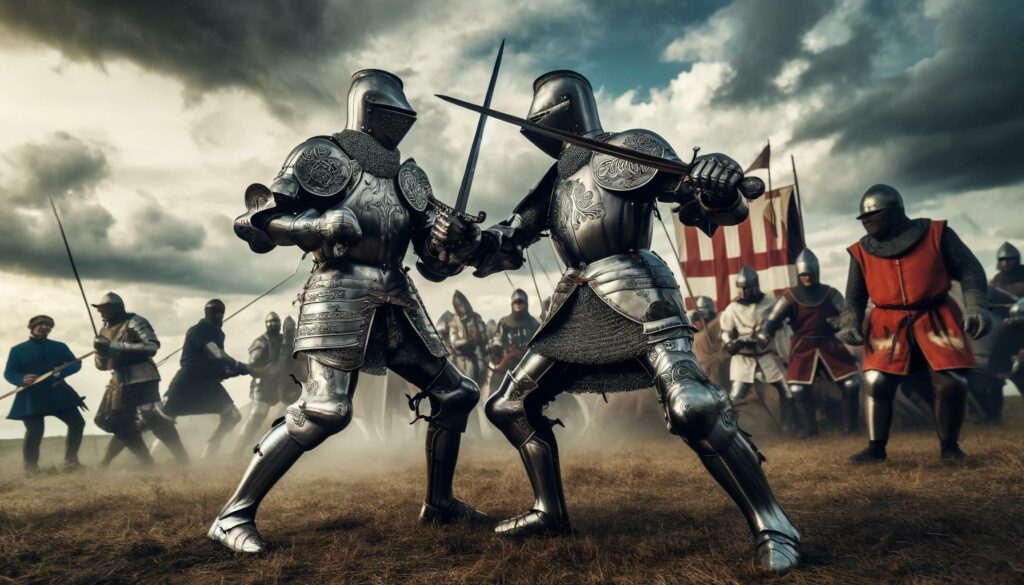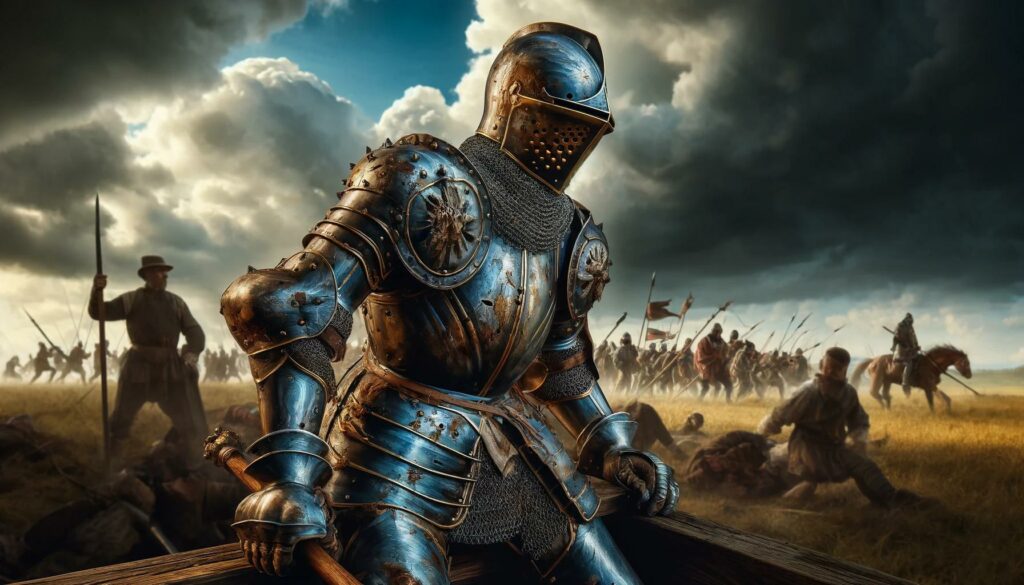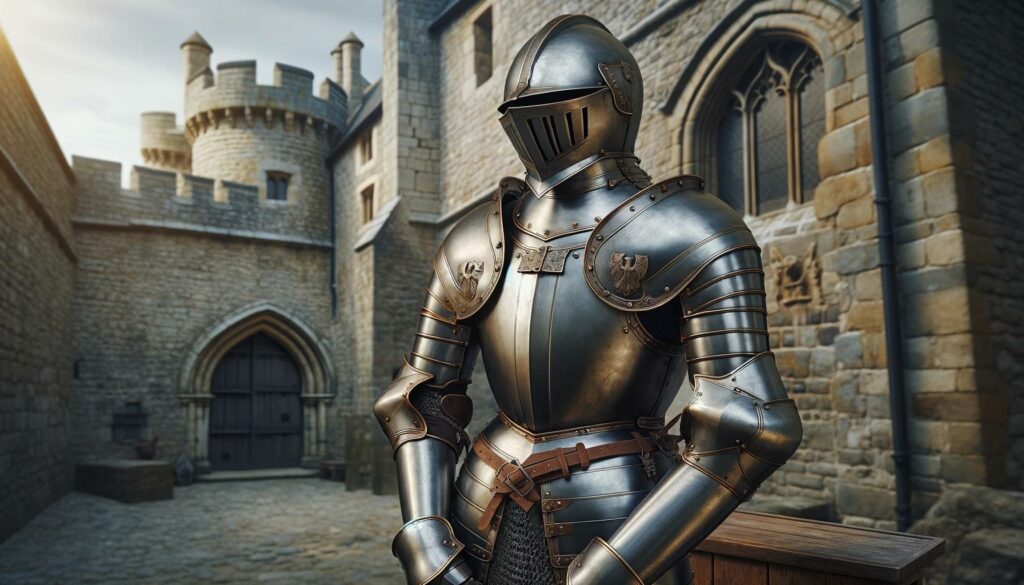Welcome to our article exploring the best material for medieval armor. When it comes to protecting yourself in medieval combat, choosing the right material for your armor is crucial. Options such as tempered steel for helmets or brigandine vests offer both protection and mobility. The material not only determines the durability and strength of your armor but also plays a significant role in your overall safety on the battlefield. In this article, we will delve into the different materials used in medieval armor and highlight their advantages and disadvantages. Let’s explore the fascinating world of plate armor, steel plate armor, titanium armor, and kevlar reinforcements and discover which material reigns supreme in medieval combat.
What Are the Best Materials for Medieval Armor?
Selecting the right materials for medieval armor is crucial for providing optimal protection on the battlefield. Here, we will explore three of the best materials for medieval armor: steel plate armor, titanium armor, and kevlar reinforcements.
Steel Plate Armor
Steel plate armor has been the go-to choice for medieval warriors for centuries. It offers excellent durability and strength, making it an ideal option for withstanding the force of heavy blows. This type of armor is made from steel plates carefully shaped and interconnected to provide comprehensive coverage to the wearer. While steel plate armor can be heavy, it offers unmatched protection against piercing and slashing attacks.
Titanium Armor
Titanium armor is an excellent choice for those looking for a lighter alternative. It is known for its exceptional strength-to-weight ratio, making it an ideal material for body armor. It provides reliable protection without adding excessive weight, allowing warriors to move more freely on the battlefield. However, due to the cost of the material and the complex manufacturing process, titanium armor can be more expensive than steel plate armor.
Kevlar Reinforcements
Modern materials have recently made their way into medieval armor construction, and kevlar is one such material. Originally developed for use in bulletproof vests, kevlar offers impressive strength and flexibility. When used as reinforcements in medieval armor, kevlar enhances its resistance against piercing attacks, making it an appealing option for modern combat scenarios.
While steel plate armor, titanium armor, and kevlar reinforcements all have advantages and applications, the choice of material ultimately depends on the warrior’s specific needs. Whether it’s the classic strength of steel, the lightweight nature of titanium, or the modern benefits of kevlar, these materials have proven their worth in medieval armor and continue to be used in modern armor manufacturing.
How Effective Is Steel Plate Armor in Medieval Combat?
In medieval combat, the effectiveness of armor was critical to ensuring fighters’ safety and survival. Among the various materials used, steel plate armor stood out as one of the best battlefield protection choices.
Mild Steel vs. Tempered Steel
When it comes to steel plate armor, there are two main types to consider: mild steel and tempered steel. Mild steel, also known as low carbon steel, offers affordability and ease of fabrication, making it a practical choice for crafting components of medieval armor such as helmets and the more flexible parts of a brigandine. However, it is less durable than tempered steel and may be more susceptible to denting and deformation from repeated blows. This is a consideration when choosing materials for Gothic plate armor or helmets.
In contrast, tempered steel undergoes a specific heat treatment process that enhances its hardness and strength, making it ideal for crafting durable helmets and gothic plate armor. This heat treatment involves heating the steel to high temperatures and then rapidly cooling it, creating a stronger material. Tempered steel armor offers superior protection against cuts and punctures, making it ideal for withstanding the forces of medieval combat. This makes it a top choice for SCA participants looking for good armor solutions.
Advantages of Full Plate Armor

Full plate armor, constructed using steel plates, provides comprehensive protection for the entire body. It consists of interconnected pieces covering the chest, arms, legs, head, and face. Compared to other types of armor, full plate armor offers several advantages:
- Enhanced protection: Steel plate armor provides excellent defense against weapons such as swords, axes, and arrows. Its solid construction and extensive coverage minimize the risk of serious injuries on the battlefield.
- Flexibility and mobility: Despite its weight, full plate armor is designed to allow the wearer to move freely and easily. The individual plates are articulated and jointed, enabling fluid movements during combat.
- Effective heat dissipation: Steel plate armor is effective at dissipating heat, preventing the wearer from overheating during intense battles. Proper heat treatment ensures that the armor maintains its structural integrity and functionality, even in challenging conditions.
Steel plate armor is highly effective in medieval combat due to its durability, strength, and comprehensive protection. Properly heat-treated and made from quality steel, this type of armor empowers soldiers to withstand the rigors of battle and increase their chances of emerging victorious. It complements well with a gambeson and helmet for optimal protection.
Is Modern Technology Enhancing Medieval Armor?
In the quest for improved armor, modern technology has played a significant role in advancing the capabilities of medieval armor. Through the application of modern materials and the impact of mass production, armor quality has seen notable improvements.
Application of Modern Materials
One key way modern technology has enhanced medieval armor is through the use of modern materials. Traditional armor made from steel plates was effective but limited in terms of weight and flexibility. By using modern materials, such as advanced alloys and composite materials, armor manufacturers have created lighter and more flexible armor without compromising on protection.
For instance, the incorporation of advanced alloys in medieval armor construction has allowed for stronger and more durable armor plates. These modern alloys possess properties that make them resistant to impact and deformation, thereby increasing the armor’s overall protective capabilities.
Furthermore, composite materials, like carbon fiber-reinforced plastic, have revolutionized armor design. These materials provide a high strength-to-weight ratio, giving armor made with them a distinct advantage. Specifically, modern armored suits, including gambesons and helmets, have become increasingly effective. The lightweight nature of modern composites allows for increased mobility and maneuverability during combat while still providing adequate protection.
Impact of Mass Production on Armor Quality
Mass production has also significantly impacted the quality of medieval armor. Previously, the armor was predominantly crafted on an individual basis, resulting in variations in quality and consistency. However, modern mass-production techniques have allowed for the production of armor on a larger scale.
This scalability has standardized armor production, ensuring that each piece meets certain quality standards. The use of modern manufacturing processes and machinery has improved the precision and efficiency of armor production, resulting in armor that is more reliable and consistent in its protective capabilities.
While mass production has yielded numerous advantages, considerations must be made. Some argue that producing armor on a larger scale has become more accessible and affordable, making medieval armor obsolete. However, enthusiasts and participants in SCA (Society for Creative Anachronism) events still see the value in traditional medieval armors like brigandine and gothic plate. However, using modern materials and mass production techniques has made it possible to create armor better suited to the modern body and combat requirements.
To summarize, modern technology has significantly enhanced medieval armor through the application of modern materials and the impact of mass production, bringing the era of gothic plate and full suits of armor into the 21st century. The utilization of advanced alloys and composite materials has improved the strength, durability, and flexibility of armor, while mass production has standardized quality and increased accessibility. These advancements have made medieval armor more effective in protecting the wearer, ensuring that it remains relevant in the modern era.
What Are the Key Features of Armor Suitable for Full Contact Battles?
When it comes to full-contact battles, having armor that can provide maximum protection is essential. The rigors of combat require armor specifically designed to withstand the intense physical demands of hand-to-hand combat while allowing the wearer to move with agility and ease. Here are the key features that make armor suitable for full-contact battles:
Protection Against Blunt Force Trauma
One of the primary purposes of armor in full-contact battles is to provide protection against blunt-force trauma. Melee weapons such as swords, maces, and axes can deliver devastating blows that can cause significant injury. To minimize the impact of these attacks, armor needs to be made from materials capable of absorbing and dispersing the force of the strikes. Plate armor could effectively protect vital areas of the body from these powerful blows, allowing the wearer to continue fighting.

Flexibility and Mobility in Combat
In full-contact battles, agility and mobility are crucial. Armor that restricts movement can put the wearer at a significant disadvantage, hindering their ability to react quickly and dodge incoming attacks. Therefore, armor meant for full-contact battles must be designed to provide a balance between protection and mobility. Armor pieces that allow for a wide range of motion in critical areas of the body, such as the shoulders, elbows, and knees, enable the wearer to perform necessary maneuvers and strikes.
Heat Regulation for the Wearer
Engaging in full-contact battles is physically demanding and can quickly generate high levels of heat. If armor does not allow for proper heat regulation, the wearer can become overheated, leading to fatigue and decreased performance. This underscores the importance of including padded gambesons in medieval armor setups. Therefore, armor suitable for full-contact battles should be made from materials that effectively manage heat, allowing for adequate airflow and ventilation. This helps to ensure the wearer’s comfort and endurance during intense battles.
By considering these key features, warriors can equip themselves with armor that provides protection and flexibility for full-contact battles. Additionally, integrating a helmet and gambeson under their suit of plate can enhance their defense. Whether it’s protection against blunt force trauma, flexibility and mobility, or heat regulation for the wearer, choosing the right armor can significantly affect a warrior’s ability to prevail on the battlefield.
Conclusion
After a comprehensive exploration of different materials for medieval armor, it is clear that choosing the best material is crucial for optimal protection. The key factors to consider when selecting armor materials are durability, strength, flexibility, and whether they can be used to craft good armor like a brigandine or a helmet.
Steel plate armor is an excellent choice in terms of durability and strength. Proper heat treatment offers exceptional protection against various weapons and attacks. Its historical significance and widespread use make it a reliable option for medieval combat.
However, advancements in modern technology have introduced new possibilities. Titanium armor, known for its lightweight yet robust composition, provides a viable alternative for those seeking enhanced maneuverability without compromising on protection. Additionally, kevlar reinforcements offer added defense against piercing and slashing attacks.
As armor technology continues to evolve, the future holds promise for further improvements, potentially including lighter, more protective plate suits and advanced helmet designs. The ongoing research and development of advanced alloys and composite materials opens doors to even more effective armor solutions. With a combination of traditional and modern materials, armor can be tailored to meet the specific needs of warriors engaging in full-contact battles.

